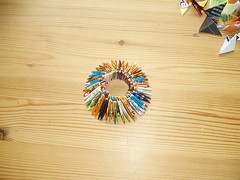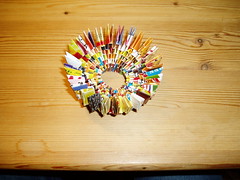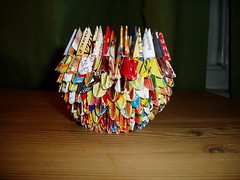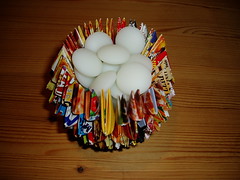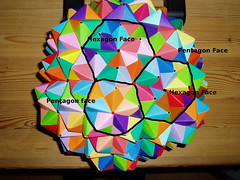This article was originally written for the British Origami Society magazine, but apparently I'm not in the clique so it was never published.
Modular origami is the process by which a number of identical 'units' are folded, then assembled to form a completed model. Almost everyone reading is probably familiar with geometric assemblies by the likes of Tom Hull and Tomoko Fuse. After a quick straw poll of London Origami members however, it appears folders are less familiar with the so called 'Chinese' or 'Golden Venture' type unit. Simple to fold from a 2:1 ratio rectangular piece of paper, these units may be assembled to make representations of birds, animals, fruit or even cartoon and Anime characters.
While assembling the history of this unit proves to be difficult. It is generally agree it originated in China and only relatively recently came to the attention of Western and even Japanese folders.
Prior to the early 1990's there are few references to the unit in Western origami media, although it does appear as if some westerners of Chinese or Taiwanese descent may have been aware of the unit as a money fold, given in times of celebration.
The story of how it came to wider recognition is a sad one. In June 1993 the Golden Venture, a ship carrying Chinese refugees ran aground off Queens in New York. Of the nearly 300 estimated aboard, about 10 are thought to have died attempting to swim to shore. A number of others are assumed to have made it and disappeared into the black economy.
The remainder, about 200 or so men and women, were arrested and held by the US Immigration service in jails along the eastern coast of the United States. Most applied for asylum, citing the Chinese regimes human rights violations. During this time, a small number of refugees held in York County Jail started folding units from whatever paper they had to hand, assembling large complex structures of ships, pineapples and swans. This and other 'folk art' spread amongst the refugees and a large number of models were created. Some of were later given as gifts to American citizens who had helped with the refugees case, others were auctioned off to assist with legal fees. In the end, roughly ten percent of the refugees were granted asylum, but the majority were deported back to China. The media attention generated by the refugees plight brought the unit and its constructions to the attention of the origami community in the west.
As a money fold, the unit was originally folded from 0.1 and 0.2 Yuan notes. These notes had close to a 2:1 size ratio, measuring roughly 90mm by 42.5mm. The gold colour of the 0.1 Yuan note symbolised riches, and a gift assembled from this note would be intended to convey a wish of good fortune and prosperity. The green 0.2 Yuan note symbolised growth and continued development.
A common money model was a ship folded from a thousand or more units, given at the start of a new business to wish the recipient wealth and success, it may also have been given at the start of the Chinese new year to similarly wish good fortune. A pineapple from 270 units, utilising both green and gold notes may also have been given to represent the wish that the recipients business would grow and prosper.

The completed unit will have two triangular tips and two pockets. For many models, assembly involves locking the units together by alternating the top and bottom lines of units so the upper unit has a tip from two lower units in each of its two pockets. This pattern may then be repeated as required for further rows.
Other Information:
http://www.mybluemoon.us/origami/
A basic introduction to the unit and a number of diagrams for assembled models.
http://www.metacafe.com/watch/442713/make_a_swan_using_hundreds_of_paper_triangles_its_a_perfect_gift/
A excellent introductory video.
The 3D Origami series of books.
3D Origami: Step-by-step Illustrations. By Boutique Sha
More 3D Origami: Step-by-step Illustrations. By S.Joie
More and More 3D Origami: Step-by-step Illustrations. By Meiko Baba.

